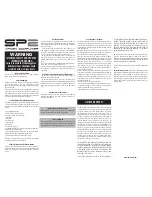
Electromagnetic Compatibility (EMC)
Read and follow the recommendations in this section to avoid performance variations
or damage to the internal circuits of this equipment when installed in harsh electrical
environments.
The various configurations of the IPS-4 Analyzer should not produce, or fall victim to, electromagnetic
disturbances as specified in the European Union’s EMC Directive (if applicable to your application). Strict
compliance to the EMC Directive requires that certain installation techniques and wiring practices are used
to prevent or minimize erratic behavior of the Analyzer or its electronic neighbors. Below are examples of
the techniques and wiring practices to be followed.
In meeting the EMC requirements, the various analyzer configurations described in this manual rely heav
-
ily on the use of metallic shielded cables used to connect to the customer’s equipment and power. Foil and
braid shielded I/O and DC power cables are recommended for use in otherwise unprotected situations.
In addition, hard conduit, flexible conduit, and armor around non-shielded wiring also provides excellent
control of radio frequency disturbances. However, use of these shielding techniques is effective only when
the shielding element is connected to the equipment chassis/earth ground at both ends of the cable run.
This may cause ground loop problems in some cases. These should be treated on a case-by-case basis.
Disconnecting one shield ground may not provide sufficient protection depending on the electronic en
-
vironment. Connecting one shield ground via a 0.1 microfarad ceramic capacitor is a technique allowing
high frequency shield bonding while avoiding the AC-ground metal connection. In the case of shielded
cables the drain wire or braid connection must be kept short. A minimal connection distance between the
shield’s end and the nearest grounded chassis point, ground bar or terminal is highly recommended. An
even greater degree of shield performance can be achieved by using metallic glands for shielded cable
entry into metal enclosures. Expose enough of the braid/foil/drain where it passes through the gland so
that the shield materials can be wrapped backwards onto the cable jacket and captured inside the gland,
and tightened up against the metal interior.
Inductive loads connected to the low voltage “Alarm Contacts” are not recommended. However, if this
becomes a necessity, adhere to proper techniques and wiring practices. Install an appropriate transient
voltage suppression device (low voltage MOV, “Transzorb,” or R/C) as close as possible to the inductive
device to reduce the generation of transients. Do not run this type of signal wiring along with other I/O or
DC in the same shielded cable. Inductive load wiring must be separated from other circuits in conduit by
using an additional cable shield on the offending cable.
In general, for optimum protection against high frequency transients and other disturbances, do not allow
installation of this Analyzer where its unshielded I/O and DC circuits are physically mixed with AC mains
or any other circuit that could induce transients into the Analyzer or the overall system. Examples of elec
-
trical events and devices known for the generation of harmful electromagnetic disturbances include mo
-
tors, capacitor bank switching, storm related transients, RF welding equipment, static, and walkie-talkies.
!
CAUTION
xiv | IPS-4 Dual Bench (UV / IR) Analyzer
Summary of Contents for Western Research IPS-4
Page 48: ...2 18 IPS 4 Dual Bench UV IR Analyzer This page intentionally left blank...
Page 140: ...4 48 IPS 4 Dual Bench UV IR Analyzer This page intentionally left blank...
Page 172: ...5 32 IPS 4 Dual Bench UV IR Analyzer This page intentionally left blank...
Page 178: ...6 6 IPS 4 Dual Bench UV IR Analyzer This page intentionally left blank...
Page 218: ...A 2 IPS 4 Dual Bench UV IR Analyzer Analyzer Light Path UV Optical Bench Schematic...
Page 219: ...Appendix A Drawings A 3 Analyzer Light Path NDIR Optical Bench Schematic CONDENSING...
Page 222: ...A 6 IPS 4 Dual Bench UV IR Analyzer Detector Board 100 2046...
Page 223: ...Appendix A Drawings A 7 Display Interface Board 100 2049...
Page 225: ...Appendix A Drawings A 9 AC Disconnection Board 100 2077...
Page 227: ...Appendix A Drawings A 11 Relay Board 100 2050...
Page 228: ...A 12 IPS 4 Dual Bench UV IR Analyzer Analog Board 100 2047...
Page 229: ...Appendix A Drawings A 13 MCU Board 100 2045...
Page 230: ...A 14 IPS 4 Dual Bench UV IR Analyzer Xenon Lamp Power Supply Board 100 2061 UV Optical Bench...
Page 231: ...Appendix A Drawings A 15 Infrared Source Assembly Interface Board 100 2838 IR Optical Bench...
Page 232: ...A 16 IPS 4 Dual Bench UV IR Analyzer Electronics Enclosure Wiring Diagram Sheet 1 of 5...
Page 233: ...Appendix A Drawings A 17 Electronics Enclosure Wiring Diagram Sheet 2 of 5...
Page 234: ...A 18 IPS 4 Dual Bench UV IR Analyzer Electronics Enclosure Wiring Diagram Sheet 3 of 5...
Page 235: ...Appendix A Drawings A 19 Disconnect Enclosure Wiring Diagram Sheet 4 of 5...
Page 236: ...A 20 IPS 4 Dual Bench UV IR Analyzer Disconnect Enclosure Wiring Diagram Sheet 5 of 5...
Page 238: ...S 2 IPS 4 Dual Bench UV IR Analyzer This page intentionally left blank...















































